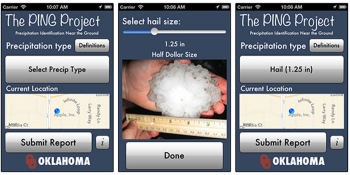New Smart Phone App Lets Public Report Rain, Hail, Sleet and Snow to NOAA
Public reports will aid weather research
It’s now easier than ever to be a part of the National Oceanic and Atmospheric Administration’s (NOAA) weather research. The NOAA National Severe Storms Laboratory, in partnership with the University of Oklahoma, has launched a free app for users to anonymously report precipitation from their Apple or Android mobile device.
With the mPING app,anyone can send a weather observation on the go. The user simply opens the app, selects the type of precipitation that is falling at his or her location, and presses submit. The user’s location and the time of the observation are automatically included in the report.
All submissions will become part of a research project called PING – Precipitation Identification Near the Ground. NSSL and OU researchers will use the mPING submissions to build a valuable database of tens of thousands of observations from across the United States. Full press release










